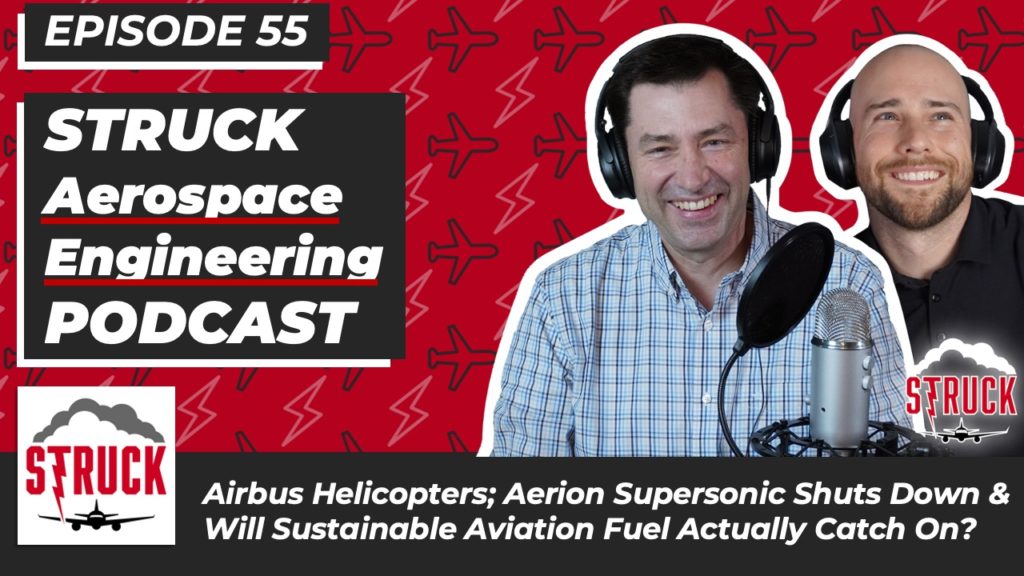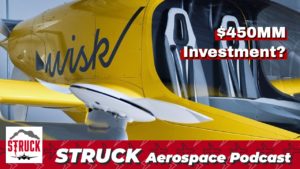In this episode we discuss Airbus Corporate Helicopters (ACH) and their 70% marketshare of the yachting helicopter segment–is this sustainable, and recession-proof? Aerion, who was making headlines with their X2 supersonic corporate jet prototype, has shut down operations. What does this mean for the industry, and should other startups be nervous? And, Allen dives into sustainable aviation fuel (SAF)–will it catch on and prove viable with new legislation proposing tax incentives for airlines that adopt it?
Podcast: Play in new window | Download
Learn more about Weather Guard StrikeTape lightning diverters and aircraft lightning protection services here. If you’re a radome design engineer, we can help. Follow the show on YouTube, Twitter, Linkedin and visit us on the web. Have a question we can answer on the show? Email us!
Episode Transcript: Airbus Corporate Helicopters; Aerion Supersonic Shuts Down; Will Sustainable Aviation Fuel Actually Catch On?
0:00
This episode is brought to you by Weather Guard Lightning Tech at Weather Guard. We support design engineers and make lightning protection easy.
You’re listening to the struck podcast. I’m Dan Blewett.
0:18
I’m Allen Hall.
0:19
And here on struck we talk about everything aviation, aerospace engineering and lightning protection.
Alright, welcome back to the struck aerospace engineering podcast. I’m your co host, Dan Blewett. On today’s show, we’ve got a bunch of Boeing related news, some other news. So first, we’ll start with Emirates, sending a warning to Boeing that it might refuse their 777 x shipment. That doesn’t meet commitments. We’ll talk about Airbus and some other helicopter market and our engineering segment today we’ll talk a little bit more about the grounding issue the electrical issues that Boeing’s had. And how does the complex fastening riveting? Just the order of operations in manufacturing played a role in that. And we’ll also talk about sustainable jet fuels and a potential tax credit that’s coming out in potential legislation. Lastly, on our EBT well segment, like a little bit about john Air Mobility as they’re trying to get a will they have a partnership now with cae to accelerate design of a flight simulator. And we’ll talk about the implications for aireon shutting down. Of course, Ariane is not an EBT well, but a supersonic jet company, now defunct, but this will certainly send a ripples throughout a lot of these throughout the industry, as a lot of these other startup companies, which were well funded like aireon, maybe wonder if they’re next. So Alan, let’s start here with with Emirates. So they warned Boeing that they were refused 777 x jets, if they fall short of contractual performance commitments, is this a big deal, or is this pretty sort of normal par for the course, it’s normal if you’re inside company to company, but it’s unusual to see that get into the press.
2:06
So somebody is getting upset, and those using the press as a leverage point. Because the aircraft manufacturer doesn’t want to be in the press about that stuff. And they don’t want it to spread that maybe their performance numbers are not being met. And on the triple seven, there’s been a lot of conjecture about the performance of the power plants, like what kind of thrust we got, what kind of fuel burn we have, because that’s critical to the operation of any airline or freighter company, for that matter of how much fuel we’re gonna burn with x kind of load in it, and what’s the range and all those kind of things. As you can imagine, if you’re the analyst at the airline company, and you’re trying to put that into your database and figure out what the cost of an airline ticket is, or what kind of profitability this airplane is going to be what routes you can fly it on, you have nothing to base that on, you just have no data without having that that’s like the most crucial piece of data of all of it is engine performance. So you can get a lot of back and forth between buyers and producers of aircraft in that performance category definition. Because it makes a big difference. So if you don’t have any numbers, and Boeing’s not going to give you the numbers, then what’s your What are you gonna do? You know, that’s right, you can make as well, I’m not gonna buy until you give me the numbers. That’s it. That’s it. But even worse is that I’ll go to the press and tell them that you’re not producing numbers, so that every airline across the world knows that you’re not producing numbers, which is bad, you know, no one wins in that situation. So that’s where they’re at right now. And I’m surprised that Boeing’s letting that go on without providing some they have to know, right? They have
3:59
to know by now. Thanks. All right,
4:01
which is what everybody’s saying is, well, you’ve flown the aircraft, you have to know You must be getting numbers on the engine performance, or is it? And why can’t we see it as it is? So you’re in any sort of, like, if you’re buying a car, and it doesn’t tell you I mean horsepower? It is what foot pounds of torque is not you kind of wonder like, Why are you hiding that? I mean, what’s wrong with this car?
4:25
When you worry about that, and the only reason you hide numbers? Yeah, the only reason you don’t publish numbers if you’re afraid they don’t live up, right.
4:32
So you got two options. You can lie about it or not, or withhold it and I guess Boeing deciding just to withhold it for now. Because it must not be what they expect it to be right. And Boeing on the honesty scale is being pressed to be honest about everything after the 737 issues on the map. So probably the best option is to say nothing as as coming. But you would think that there ought to be a lot of phone calls going back and forth between now airlines and And the triple seven staff to get that corrected. It’s weird. Weird combative situation. So early in a program.
5:09
Yeah. Well, moving on. Let’s talk a little bit about Airbus. So Airbus corporate helicopters, they now have a 70% share, reporting from Ayane, online of the yachting market, which they talk about how this is a, it’s a challenging market, but one that’s been pretty resilient to the pandemic literature. Makes sense, right? So if you are wealthy enough to own a yacht, that you can land a helicopter on, you probably weren’t hurt too badly from the pandemic. And well, of course, you know, these may be business owners, they may have taken a large hit or maybe had to shutter business. But I think the idea is that with the stock market being what it was a lot of, you know, model wealthy people put money in when it was down and made a boatload of money thereafter. So only a boatload. Yeah. Well, and it’s it’s interesting, this article talks about, you know, ultra wealthy people wanting to sneak away to their yacht and quarantine and yeah, you know, be away from big crowds, even as life is resuming or starting to resume as normal. Exactly. But is does it strike you as a pretty resilient market? I mean, do you feel like the luxury market in general is, is relatively resilient to these kind of these kind of, well, disruptions?
6:21
It is it tends to be what you only time you see real trouble is on economic collapse collapses, like the 2008 in the US or across the world, actually. were sort of large yacht sales just collapsed. And then the helicopter market went with that everything caught I went with that on the on the housing market side. So you can you can, I think on some level trace aircraft sales with other sort of luxury item sales. Yep, big boats been another one of those items. So big boat sales are doing well. Airplane sales tend to be doing well. And it’s it’s funny that Airbus called out like, Where are the yacht company where the yacht helicopter company, we went 77 out of 10. yacht aircraft? That’s us. So you’re the one to come. We’re the one that has the best aircraft to land on your yacht, which is a weird thing to think about. Because we were talking about the use of helicopters, like where are they being used right now? Well, where’s a great place to sell the helicopters with someone who has cash who has cast and somebody with a yacht has cash. So that’s a great place to sell a helicopter versus in a more competitive market, like on a training market or an oil rig market? those tend to be a little more cost conscientious, so to speak. So I’m sure I’m sure that the yacht helicopter market is a sweet profit margin market and you want to live in there if you can. But isn’t it just a just a little bit odd and the way that Airbus sort of constructed that argument like, it’s it’s the argument of, well, we’re the leader in that space, so everybody else doesn’t matter should always come to us. Which is a great sales argument, by the way, like, if you don’t know anything about helicopters. And you see that Yeah, well, I guess I call Airbus since they have 70% of the sales here. I’ll call Airbus because they know what they’re talking about. Yeah, it’s it’s a great marketing tool to pull that one off it but from a
8:27
helicopter rich get richer? Well,
8:29
it’s sort of, I mean, sort of, right. If someone buys a helicopter, there’s a lot of people making that helicopter. So you’re taking that money and putting a lot of people to work, which is super awesome. I think the question, and this ties into the Airbus kind of stepping away from the retail market for a while and saying it’s not ready yet. One of the easier time markets is going to be landing on your yacht. Come on,
8:55
for sure. Right. Yeah.
8:56
So Airbus is say saying that those aircraft are not ready for that yet. It’s not ready for that. It’s not ready for the for the big time. We’re going to be okay, making helicopters for the next couple of years, at least
9:08
one last piece of news today. And of course, this is tied to the aireon collapse, GE Aviation is no longer working on the infinity. So obviously, they’re still going to be involved with the NASA x 59, which is the supersonic tech demonstrator. But they’re, you know, stopping plans here because the Infinity was the power plant for the as to business jet, right. Obviously, you know, all these systems go with it. But I mean, I think the bigger point here is that when a company, especially an Aircraft Company, which has lots and lots of vendors and you know, other companies helping to put the plane together, it’s it’s a big ripple effect, is it not?
9:49
Yes, anytime in aircraft program shutters, you obviously lose all the aircraft manufacturing, but you also lose on the engine side. Everything tends to stop there too, because a lot of engines are directly manufactured for a particular model of aircraft. Don’t forget if it’s supersonic or not, doesn’t really make that much difference. Every aircraft has a slightly modded engine for his particular application. So it’s a huge downwards chain of businesses losing future revenue, right, so everybody loses in the situation. So aireon loses, obviously, all the employees lose all the suppliers lose, including GE, in this case, all the GE employees that would have been supporting that program, have to find something else to work on now, it just cascades and it’s almost immediate haven’t been involved in that a couple of times. My aviation career, when a stop order is put out for an airplane. They couldn’t it stop and today, that’s it, stop work, stop billing. We’re not going to pay any more bills associated with this program. It is over it is it like there’s a slow decline at some sort of bankruptcy sort of thing. It is like we don’t have any more cash, boom, stop. It’s not like that a little bit of businesses, but that in aviation it is. So you can literally take a 10,000 person 30,000 person organization and Toby go home, boom. That’s big on a local economy. It just is when you have those kind of numbers stopping work in any particular project. It has a big impact locally and nationally.
11:28
Yeah, that’s just like you go to the grocery store and forget your purse. And it’s like, well, gotta leave it got to go home. Just leave. Leave it here. Right. Right. Right. Yeah. Back home. Yeah,
11:39
well, yeah. It’s like going to the grocery store. And yeah, I’ve been forgetting something going back in the doors closed, like is this like that, like, You’re not coming back in? That’s it, we’re done. It’s over. It is like that. And you don’t think of it that way. And if unless you’ve been in that situation, not really realized that’s how abrupt it is. It’s not like, I only have layoffs in Detroit, they tend to be longer, 60 day, 90 day kind of events. And they there’s all notices and all that kind of stuff. It doesn’t go that way in aviation typically.
12:16
Alright, moving on to our engineering segment. First, let’s talk more about Boeing the 737 max incident with their electrical grounding problem. So interesting memo sent out well reported on by the Seattle Times. But basically Boeing has cautioned their engineers about changes to manufacturing steps just to make sure that they’re all aware of just little things that can make a big difference, which apparently was the the issue here. So Alan, it sounds like they used to rivet a hole. And the electrical connection created by the rivet fasteners was different structurally and electrically then the replacement fasteners they found a faster process and there was like a little cheaper, a little faster, and didn’t have as good of an electrical bond, or grounding as, as the rivets that seemed like that was kind of watch reporting and there weren’t warning their engineers to be, you know, mindful of that,
13:08
Oh, sure. changes and faster types in particular, are faster diameters, which doesn’t seem like to be all that much difference, like slight changes 1000s or to changes in diameters of astronauts can have big effects on electrical connections being made. And the note from Boeing basically says, Be careful when, from the going from engineering drawing to manufacturing, actually on the line, that everybody’s trying to optimize everything about an aircraft in terms of how much it cost to make part. So if you can reduce the part count, if you reduce the amount of labor it takes to install it, or the time it takes to assemble a piece, you’re going to do it and then that translation, sometimes you forget the little detail, things like logical grounding and bonding, it gets, you’re still fasting things together. So you’re basically fasting two pieces of metal together, but how you fasten it and all the steps it takes to assemble those two things is critical to the outcome. And unless you are put some sort of pass fail criteria on electrical bonding everywhere and you’re measuring all that stuff, you won’t catch it. So there’s a lot of people involved from the design phase of creating a drawing, which defines what this installation look like to a person on the manufacturing floor, assembling it and installing in an airplane, there’s there’s just a whole breadth of people between those two things. So in there is where the details matter. And if you don’t translate the engineering drawing or the engine drawing us into sufficient detail, everybody else down the chain can get lost and meander off where the pathway that the engineer thought they were going to be on. And then you got a different product at the end. And so unless the engineer physically goes down to the line and checks once in a while, which is what I prefer To do this actually see if this thing’s actually installed the way that I intended to install it, because I know what it should look like, then then you can get a different result. And I and a large company like Boeing, it’s inevitable. I think it’s inevitable. It don’t want it. But it’s really hard to control that situation when you have so many people. It just is. We start with a max, and we’re gonna we start with this bonding issue. You see it? on air, all aircraft companies have that similar issue. It’s a constant battle of design intent, and what’s being built? And are they are they aligning with one another?
15:39
Yeah, that makes sense. And like you said, so many people, so many complex processes, they get changed last minute, and doesn’t seem like it’s a big deal. No one really noticed this, and then suddenly, they find a problem later. So,
15:51
right. Right, there’s a lot of assumptions that are made on an airplane, right, especially an aluminum airplane. Things comfort are taken for granted, because they usually limit airplane, in terms of my area of expertise was a lightning protection. Aluminum airplanes are easy, because once everything’s kind of connected together, inherently, structurally, that also usually means it’s inherently connected together, electrically. But because processes and corrosion protection, and everything is much better than it used to be. things we take for granted, in terms of, if I put a couple of rivets in this part, it should be fine, electrically isn’t. It’s not anymore, just for a variety of reasons, mostly because coding so much better. So I think putting out a memo is like the least you can do. And I think you have to put the memo out to say, Hey, everybody, take us take a deep breath, make sure your designs have been implemented properly. But it goes deeper than that, that you need to sometimes kick the engineers out of their seats and make them go down the line and take a look at what’s actually coming down the line.
17:00
So moving on to our second here, second item here on the engineering segment. So there’s new legislation introduced by three Democrats, the sustainable skies Act, which is aimed at reducing you know, emissions. And it would establish $1.50 per gallon tax credit for sustainable airline fuels, aviation fuels, and then then additional penny for every percentage, above 50% reduction in emissions. And so then the initial dollar 50 tax credit is on the assumption that that’ll save 50% of the emissions for over typical jet fuel. But Alan, you’re skeptical of this,
17:39
I think the difference between the cost of the alternative fuels is more than the buck 50, you’re going to save in a credit until the synthetic fuels can lower the cost down significantly, I think you’re gonna have big issues with it. So that that’s the big, that’s the big problem, right? anything you’re trying to create, to turn into a fuel takes a lot of energy to turn it into that fuel, which then makes it more expensive versus pumping it into the ground refining a little bit and sticking it in an airplane wing. There’s just a lot more steps a lot more energy, a lot more people involved and making synthetics just is that means the cost is going to be higher. So if you’re the aircraft Operator, do you really want that maybe, maybe that’ll pay off in terms of better PR or something. But the buck 50 doesn’t make sense economically right now, I think all the airlines will pass. There’s like, No, I don’t care. It’s not it’s not making it financially worthy to me. And don’t think that there’s not a group of accountants and every airline across the United States, and then basically across the world in the same thing, looking at the cost of fuel, that’s one of the main drivers into the profitability. They’re not going to double the fuel costs. No way, there’s not going to do it. Because their price, their pricing has got to increase by 20 30% versus their competitor. They’re just not going to do it. So I think there’s I think, as we’ve talked about many times before, the aircraft industry isn’t gonna really good job on reducing fuel and being much more efficient than they were 10 years ago, definitely more than 50 years ago for sure. Do we need this? I doubt it. I doubt it. It’s like a similar thing to happen to Massachusetts recently, where they had a legislation legislature had a bill that was going to charge $1,000 landing fee to every aircraft, private aircraft that landed in Massachusetts 1000 bucks. So if I have my Piper or whatever, Seneca or whatever, and I land at my local airport as 1000 bucks. Oh, it’s just no one’s gonna do that. No one’s gonna land in Massachusetts just won’t they’ll drive the land in New Hampshire or Vermont and drive over. That’s crazy. There’s an economic economics to it. That has to make sense and the point of the point of the tax was to punish people who are flying or elect quarterback punish people who are flying around in luxury aircraft. Why are using taxation to punish people? That doesn’t jive? That’s not what taxation is for. Right? So you kind of feel like the same thing like this little credit as a way to sort of punish people from flying on airplanes. And, as we’ve talked about many times before, aircraft are the most one of the most efficient and safest modes of transportation ever on the planet. Do we want to tinker with that? Not a lot,
20:33
I don’t think yearly, it’s about 26 billion gallons of jet a fuel consumed by the airline industry and prices for you know, standard jet a somewhere between the mid threes per gallon to like the low fives right now. So you’re saying that it’s it’s finding exact pricing on these synthetic fuels is difficult, but somewhere double or more, or they’re blending on for decent synthetic fuel fuel. So then they’re blending, the cost is not going to be as effective.
21:02
Right? Right. And the synthetic fuels don’t have much energy density. So for cubic, whatever, gallon or whatever, it’s less energy and contained in it. So you need more fuel to go further, which means more weight to go further.
21:16
There’s a cost benefit could even just be a push. Yeah, yeah, that’s, it seems it does seem really problematic. And you wonder if the lawmakers knew this, when they released this legislation like, did I mean, you would assume that all these numbers kind of got run by them just words, like, hey, this probably isn’t gonna work very well, given the current prices. And the fact that if it’s not mandatory,
21:37
if you haven’t ever meet a legislator, they got a lot on their plate already, because they’re dealing with a variety of issues. And if your legislators staffs in Congress, they’re not really experts in anything in particular, and they’re not dumped tend to be very old. So isn’t like they have a lot of experience in the aviation field either. So these things tend to be more promotional efforts than they are effective legislation in terms of driving a industry somewhere in aviation always tends to push back, because we have the data. United Airlines has the data on synthetic fuels. They do. And you know, delta does too, right. So they know, they know, you’re going to bring in front of Congress and talk about the alternatives. Awesome. But I don’t, that has, to my knowledge, that hasn’t happened, there’s been a lot of push inside the FAA and Europeans to look at alternative fuels. That’s awesome. But economics still isn’t there?
22:40
Well, and maybe it’s some or you just start to introduce this now, assuming that it’s not going to go anywhere, just to start like that ball rolling, to get the airline industry thinking about it. And, and people, you know, other legislators signing off on it, and then maybe 10 years down the road, when prices are closer, it starts to matter. You know, it could just be like, hey, let’s just do this thing. Even that won’t do one effect must change, just so that maybe it starts to affect change in the future. Maybe, Nick, it could be something like that, you never know. Well,
23:10
here’s the thing, Dan, I think the a lot of people who, whose job is it every day to look at how to make an airline much more efficient than it was a day before. There are 1000s of people doing that every single day. And I will rely upon their expertise more than someone in Congress. But I also think on a bigger picture scale, is the Ilan musk effort, which is going on now on carbon capture a better alternative than changing every airplane. Maybe, maybe, maybe that’s a better solution. And and maybe, maybe that’s ultimately the end solution is the carbon capture method, because we really haven’t examined that all too much. But it may be the way that all this sort of mitigates itself is that we don’t re engineer every industry, every piece of transportation to the world versus come up with ways to sort of mitigate it on a global scale. I don’t know, I don’t know there’s a good answer for that. But at least I’m at least glad that someone is looking at alternatives. And if that’s masking, some others great. I’m surprised that some of the European countries, even the United States haven’t looked at it from a national sense.
24:28
It’s just going to take all these efforts. It’s so it’s so complex, as far as reducing overall like you get to Is it a short term smaller thing you’re aimed at reducing or is it a larger thing I was reading this book called upstream by chip Heath and an example he uses in the book is plastic grocery bags. So these really thin you know, the standard thing grocery bag you get for, you know, now you pay five cents for it here in the District of Columbia. But you know, these plastic bags Obviously ended up everywhere, right? They just wafer thin. And so if you think, Okay, let’s try to reduce the amount of plastic bags, which is in the billions us every year. What if we go to paper bags which are obviously more environmentally friendly? Well, they’re significantly heavier. You and they essentially ran the numbers on the thin typical grocery bags versus the paper bags versus like the thicker you know, reusable ones, they basically said you had to use a paper bag at least three times for it to break even while for the whole scope of like, carbon emissions. And like this whole balance, I can’t remember the exact measure they’re talking about. But for it to be actually better for the planet, you had to use a paper bag three times at least. And then a reusable bag 100 times. So really, now, okay, you now know using either one will certainly get less of the thin little paper bags out of the waterways, right? But it won’t reduce like co2 emissions over the entire planet. So really, the little plastic bags are probably better for the planet, unless you’re going to use this paper bag. So he times and your reusable 100 times. That’s what’s really interesting. So you could potentially solve one problem getting those little bags out of, you know, landfills and waterways. But you wouldn’t solve the bigger problem that actually make that problem worse. So by going to paper or going to only reusable if they’re not used enough, so
26:17
isn’t that the system versus goal approach to that, right? We want to put a system in place that reduces overall, I don’t really care how we do it. But the thing is the goal approach to reduce it just to reduce, and on a number of different levels, right. So you got carbon dioxide emissions, you also have plastic waste issues, right? So if you’re trying to minimize all them, it you have to look at as a system. And that’s what you that’s what you just went through. Like it’s not just that we create this paper bag, but that we also it takes more to transport it in. Yep. Right. So all those little variables don’t get thrown into an in an ordinary individuals thought process. Because you’re doing think of it, I wouldn’t have thought about the weight of a bag versus a plastic bag when it crossed my mind. It matters.
27:07
Yeah, hmm. Well, it’s funny, I was thinking about that a Trader Joe’s, most of the grocery stores, they go to your, like Whole Foods or Trader Joe’s have those nice handled paper bags. And I actually wonder that as I was waiting in line, I’m like, they’ve got to have just a gigantic pallet of these paper bags somewhere in this building. They they’re not. I mean, they’re thick. And they’re well made bags, versus those little reams of plastic bags that they you know, pull one off for the typical version, once you get fit 1000 of those in the same space that maybe you store 15 of these paper bags. I mean, it really is a big difference when they talk about that’s where the shipping costs come in. I mean, right.
The big story today, we’ll get to in a minute. So first, let’s talk about CIA. So and this seems like a pretty cool step that john aircraft. They are, you know, john Air Mobility, they’re partnering with CAA to develop a flight simulator. So CAA is a well known, well regarded flight simulator company. And they’re, you know, moving forward to start this whole process of getting the john Air Mobility aircraft, hopefully certified by 2026. So, I mean, is this a typical like is, in 2021, is this seemed like the right timing for this step
28:29
it is, but a lot of times it’s it’s handled internally, they will, an aircraft company won’t outsource the sort of the iron bird portion or the simulation portion of an aircraft design, they’ll try to keep it in house. But John’s making a couple of different moves simultaneously. One is that they’re moving from, like the New Jersey, Philadelphia area up to Canada. That’s the first move. And then the second move is, is they’re trying to connect with local Canadian companies. Probably I had some work with bombur Lombardi a aerospace, which is down on a slot right now. And so there’s probably a abundance of aerospace workers that have time to work on things. And so they’re trying to grab hold of that. And I think that makes a lot of sense for john. When you’re trying to create us a simulator or simulation tools for an aircraft design is really important. In terms of the final what the final aircraft looks like, because there’s so many interconnected pieces you don’t really think about an aircraft is like a living breathing organism, but it is very similar to that. And that first time you turn on this living, breathing organism on us simulated workbench or iron bird type simulated, simulated setup, it rarely works like you intended it to. There’s all the little all of the details start to matter, and that’s why you want to have something simulated there and trying to get it all the bugs worked out because it’s easier to do it on a on a on a plywood bench. versus a $3 million aircraft out in the hangar. So you try to get those systems things worked out early. And so this, this whole thing makes sense. It’s just, it’s just interesting how john is bumped up to Canada and is starting to utilize all those Canadian aerospace resources, which there’s, there’s a bunch of Canada has been a great resource for Aero space talent for a long time. So it’s a it’s a good feeding ground for your new Aircraft Company to go take advantage of. And that’s a pretty smart move by john.
30:35
So lastly, and this is I think the big interesting story of the week is aireon, supersonic, shutting down. And of course, we’d mentioned them in multiple podcasts over the last 12 months, doing some cool stuff, they’ve got their cool prototypes. You know, net jets had a big order with them. And that’s obviously going to have to, I mean, not have to wait, but just on hiatus for forever, I guess until the next supersonic company wants to take on this challenge. But I mean, Alan, does it surprise you that a company like this is suddenly just defunct out of money stopping all processes like we’re done?
31:13
Well, it has to do with investment more than it does technology, I think the Boeing was an investor in the company at some level. And I know there was a relationship between aireon. And Boeing was going to support on the engineering scale where they had engineers helping, helping aireon because Boeing builds supersonic aircraft on the on the fighter side. So they have a lot of knowledgeable people know how to do that. And in this particular case, once Boeing financially gotten a little bit of trouble, they can’t support things outside Boeing, or, you know, the Board of Directors is never going to allow that to go on. They need to remove those from the books and the liabilities from the books because Boeing’s got to continue as a company, so aireon takes the brunt of that. So once that relationship starts to break down, because financially, one of your partners is in trouble, there’s really not a lot to do there, you truly can’t do much. And I know that it was a couple of things about Ariane really stand out. And I always sticks in my head as little warning bells, at times, the amount of money that we’re spending to develop a whole new manufacturing site was really expensive. And the place they were doing it was in Florida was great weather and has all the advantages that plus you can fly off the coast and go break the sonic boom, off out in the ocean where you need to go do it. And that all makes sense. But the cost of some of those things is so enormous, that it was more than the cost of some aircraft programs, like I think they said it was gonna be $300 million plus on the manufacturing site, and just for the buildings and the infrastructure, with $300 million, we’ll build you an airplane. Those kind of details you can move, and he’s been leaner. And just like that, that whole business intuition kicks in and goes, Okay, we got to do those leaner, we got to find out, we got to find some existing hangars, we got to set up some office space, it’s gonna be lean for a while until we get the airplane kind of figured out. And we’re starting to manufacture stuff. And it’s just just just another one of those things that just didn’t feel right. And I don’t know how else to describe it. But it’s just like, you see big cash burns, and we don’t see a product coming out the you know, I don’t know how long you can sustain this, they can’t. And boom, here we go. So, you know, I don’t fault anybody here. I think we’re just sort of the, when you’re building a supersonic aircraft, there’s a certain things that have to go along with it. So you can attract people into it as investors and buyers of it. And so you’re playing at sort of this Lamborghini Ferrari kind of environment. But you need to be building Chevy kind of factories. That’s the difference. And it hurts. It really hurts. But I thought this was a was a time where the supersonic aircraft and a sort of a business commercial scale could come back. And then now the only real player it is boom, right? And boom is Airbus, essentially. So there’s, you know, it’s a huge risk. SuperSonics always a huge risk. I just don’t know if we’re going to see it in in again for another 20 years. That’s what it feels like.
34:29
Well, the cost was going to be 120 million per plane. How does that stack up? versus like a 737? Max?
34:37
Yeah, Max is nowhere near that cost.
34:41
Yeah, that’s what seems obviously like the supersonic technology is expensive. Oh, yeah. But sure. That just Yeah, but that’s, that’s a hefty price, right.
34:50
And I think if you’re an any sort of new startup, or even a continuous continuation of a company, you want to go that direction. You just got to be super lean on everything. And I know it sounds outrageous. Well, how can you be super lean and your business cool looking airplane, you have to because you can’t waste any time wasting money, but you don’t have any spare money to burn here. We need to we’ve got so much invested in the engine technology on the aircraft technology side, that you just got to be tight with funds. And, you know, Boeing didn’t think it was tight enough. That’s what appears to have happened, I think you’ll see where you’ll see a Seattle Times article about it, I think in the next month or so, which will delineate how this all went down. Because right now, there’s not a lot of information about it. But you should be seeing something in the next month or so.
35:48
Well, and so here’s my last question for you is, is this going to spook a lot of these companies in the VTOL sector obviously a different market than Ariane was in but very similar feel like these are startup companies haven’t produced a plane yet? haven’t sold at owning? They’ve got some orders, right? But they haven’t been been paid for many of these. So are these companies going to be spooked?
36:12
I think the human nature part of it would say no, because if you’ve already committed funds to it, you are already in your mind knowing that this is going to happen. You’ve already convinced yourself it’s going to happen. So it’s hard to back out. Very few investors will back out suck me They probably some of the most diligent ones that are really know how to play that. But a lot of times once they put even on deposits, for that matter, you put a deposit and you’re very reluctant to pull a deposit back and go put a deposit somewhere else that doesn’t happen that often you made a mental physical commitment to a thing a you don’t want that to stop because you’ve already given your your validation of it. That’s a child Dini principle, right? That’s a child Dini principle, but it’s true cost. Yeah, the sunk cost as as good economics professors will teach you sunk costs is gone baby in a coming back, right?
37:09
There’s no way good poker players,
37:11
two poker players, you
37:12
start chasing chasing that money, that money is not yours. As soon as it’s in that pot, that money is
37:17
gone, right? And you can’t get it back. And so you have to play your odds based on that money never coming back and look at what the next opportunity is. And do you want to continue invest more and everything’s restart, you need to relook at it all the time. And good investors in aerospace will do that. people that believe in passion, get sidetracked and lose perspective and end up losing a bunch of cash because an aerospace passion does not matter. It does not make any difference in where that airplane is going to be created or perform like it’s supposed to. has zero to do with it. Zero to do with it. And I think we get hung up on some things like that, like, Oh, this is the next cool thing. Yeah, I may be totally right. So he hang being one of those things, right. But it, it only matters if it comes to reality. It does what it says is gonna do. That’s the only thing that matters. And passion has nothing to do with it. It matters that all the details are in place. And it’s a it’s a good product and you can prove it. Until then, you gotta be careful with your money. You really, really do on the investment side and I and hopefully, a lot of Eb tall investors are really looking at their investments and saying, Yeah, there are some companies out there and there are that are headed in the right direction that are spending money wisely, and are efficient, like getting to an aircraft design. That’s what you want to see.
38:44
All right. Well, that’s gonna do it for today’s episode of The struck aerospace engineering podcast. Thanks so much for listening. If you’re new here, be sure to subscribe on YouTube, Spotify, iTunes, Stitcher, wherever you get your podcasts. Thanks again and we’ll see you here next week on the stroke podcast.
StrikeTape Weather Guard Lightning Tech proprietary lightning protection for radios provides unmatched durability for years to come. If you need help with your radon lightning protection, reach out to us at WeatherGuardaero.com that’s Weather Guard a e r o.com












